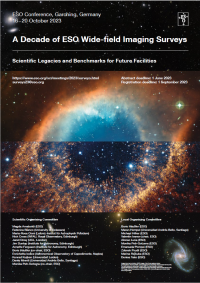A Decade of ESO Wide-field Imaging Surveys
16 - 20 October 2023
ESO Garching
Scientific Rationale - Summary & Motivation
With the change of operations model of OmegaCam@VST (first light Oct 2011, now under INAF agreement with ESO) and VIRCAM@VISTA (first light June 2008, decommissioned March 2023), a decade of targeted wide-field imaging at ESO is coming to an end. Both instruments were largely dedicated to public imaging surveys, which have amassed a total of nearly 60000 hours of telescope time.
To commemorate these milestones, this 5-day workshop reviews the legacy left by these instruments and summarizes the variety of scientific impact that these imaging surveys have on a wide range of research topics in astronomy, both in galactic and extra-galactic science, and that have helped to shape the picture of the universe that we have today: galactic star formation, the structure of the Milky Way, stellar populations of the galactic plane, transient and variable objects over exploring stellar populations in the Magellanic Clouds to studying dark energy, investigating galaxy evolution and the evolution of galaxy clusters, baryonic acoustic oscillations as well as mass assembly in the very first galaxies.
The main goal of the workshop is to further advance science cases, create international collaborations among research groups and encourage new ideas from/within the community to enlarge the exploitation of the high-quality VIRCAM and OmegaCAM survey data and last but not least, to promote the usage of the archival data form these facilities.
The synergy of the VIRCAM/OmegaCAM legacy with the new generation of wide-field imaging facilities and missions, e.g. Euclid, Nancy Grace Roman Space Telescope, LSST/VRO and others will be discussed.
The workshop will take place at the ESO Headquarters in Garching near Munich (Germany). The possibility for remote attendance will be supported by this workshop, using TEAMS. More information is given on the registration page.
Conference topics
The programme is structured around 3 key topics:
1) Galactic science
a) The inner Milky Way: uncovering the structure and assembly history of the central parts of our galaxy, completing the census of star clusters.
b) Star formation sites in our Galaxy, compiling an atlas of stars in all nearby star formation sites including sources down to a few Jupiter masses, inaccessible for Gaia.
c) Milky way satellites and the Magellanic Clouds, their resolved stellar populations and star formation histories.
d) Variable stars and transient science: young stellar objects, Cepheids, and other pulsating objects in the Milky Way and nearby galaxies. Follow-up of gravitational waves detections and characterising those.
2) Extra-galactic science:
a) Star formation and stellar populations: What properties of galaxies drive their overall star formation activity? How does star formation (and their distribution within galaxies) change with time? Can we use the present-day spatial distribution of stellar populations in nearby galaxies to reconstruct their past evolution?
b) The environment of galaxies: What can the spatial distribution of satellites and neighbouring galaxies around a galaxy tell us about the assembly of said host galaxy? How do mechanisms like harassment, starvation or ram pressure stripping affect galaxies in clusters? How much of this evolution takes place already inside the clusters or via preprocessing before falling into the clusters?
c) Galaxies as cosmological probes: How does the large scale distribution of galaxies constrain cosmological models? How well do current surveys constrain Baryon Acoustic Oscillations, and how will future surveys improve upon this? Do we have a complete census of baryons in the universe? EUCLID, LSST and other future facilities are designed to answer these questions.
d) Galaxy Evolution: How do galaxy mass functions evolve with cosmic time? How do scaling relations evolve and what can we learn about the formation, assembly and evolution of galaxies? Alternatively, we could also/instead split extragalactic by distance instead (e.g. nearby galaxies on Day 4, high redshift universe on Day 5).
3) The road ahead:
a) Recent and upcoming surveys, both at ESO and other observatories (e.g. Euclid, LSST), as well as synergies with ALMA, JWST, the Nancy Grace Roman Space Telescope, UNIONS/CFIS, DarkEnergySurvey, HyperSuprimeCam SSP.
b) Introduction or hands-on session on how to access the public survey data, possibly via training videos (TBC).
c) Lessons learned: Feedback from public survey PIs. What lessons can other wide field surveys learn from our experience?


